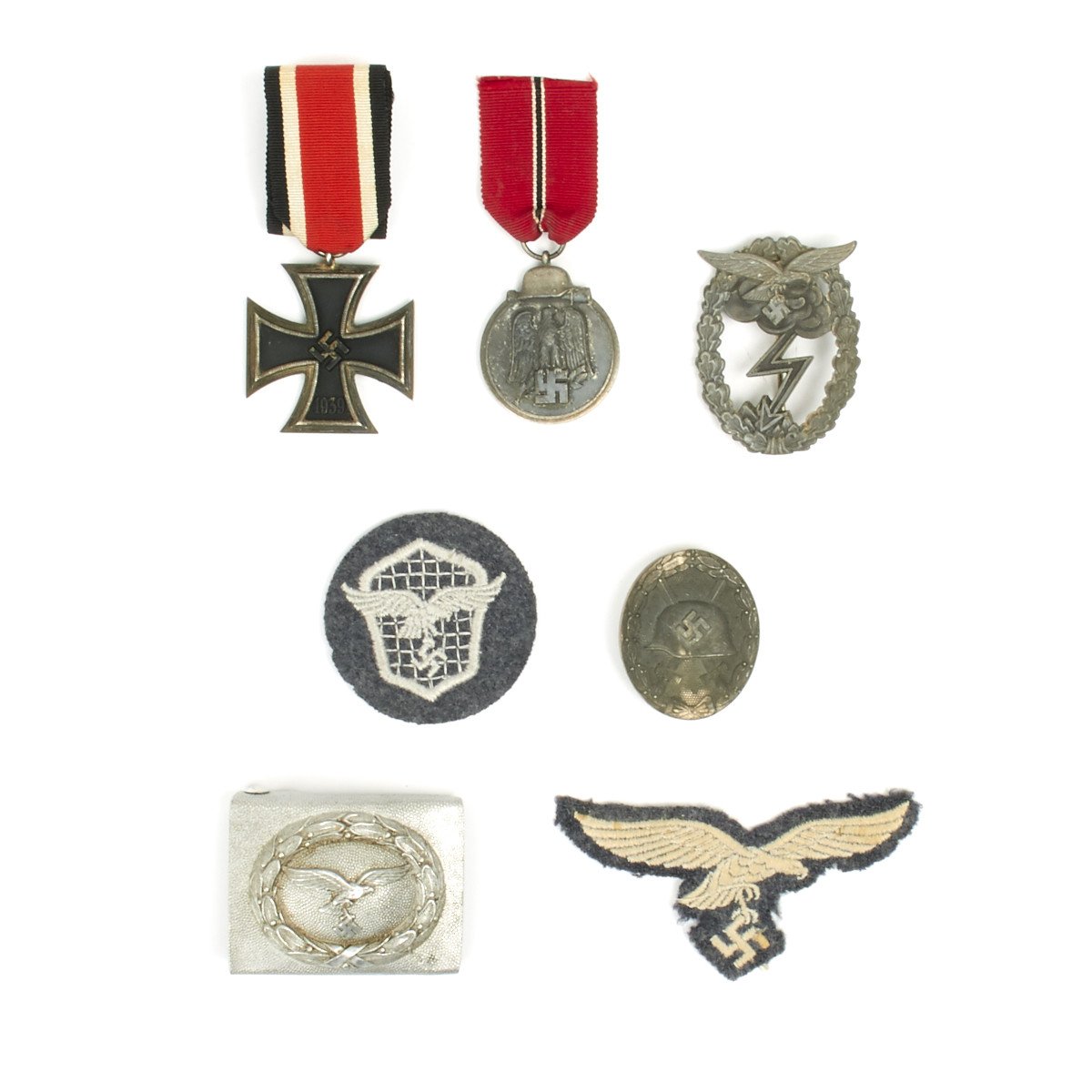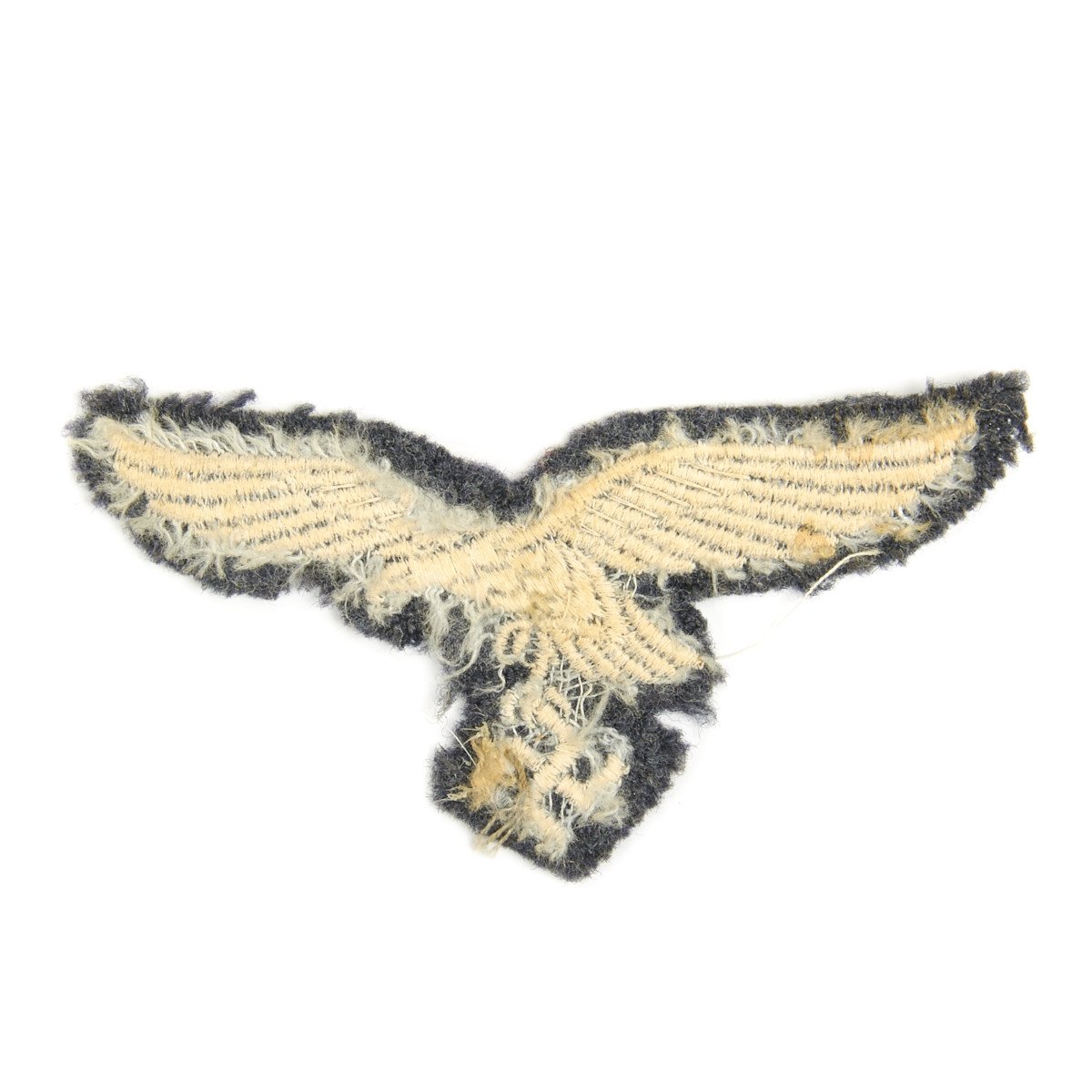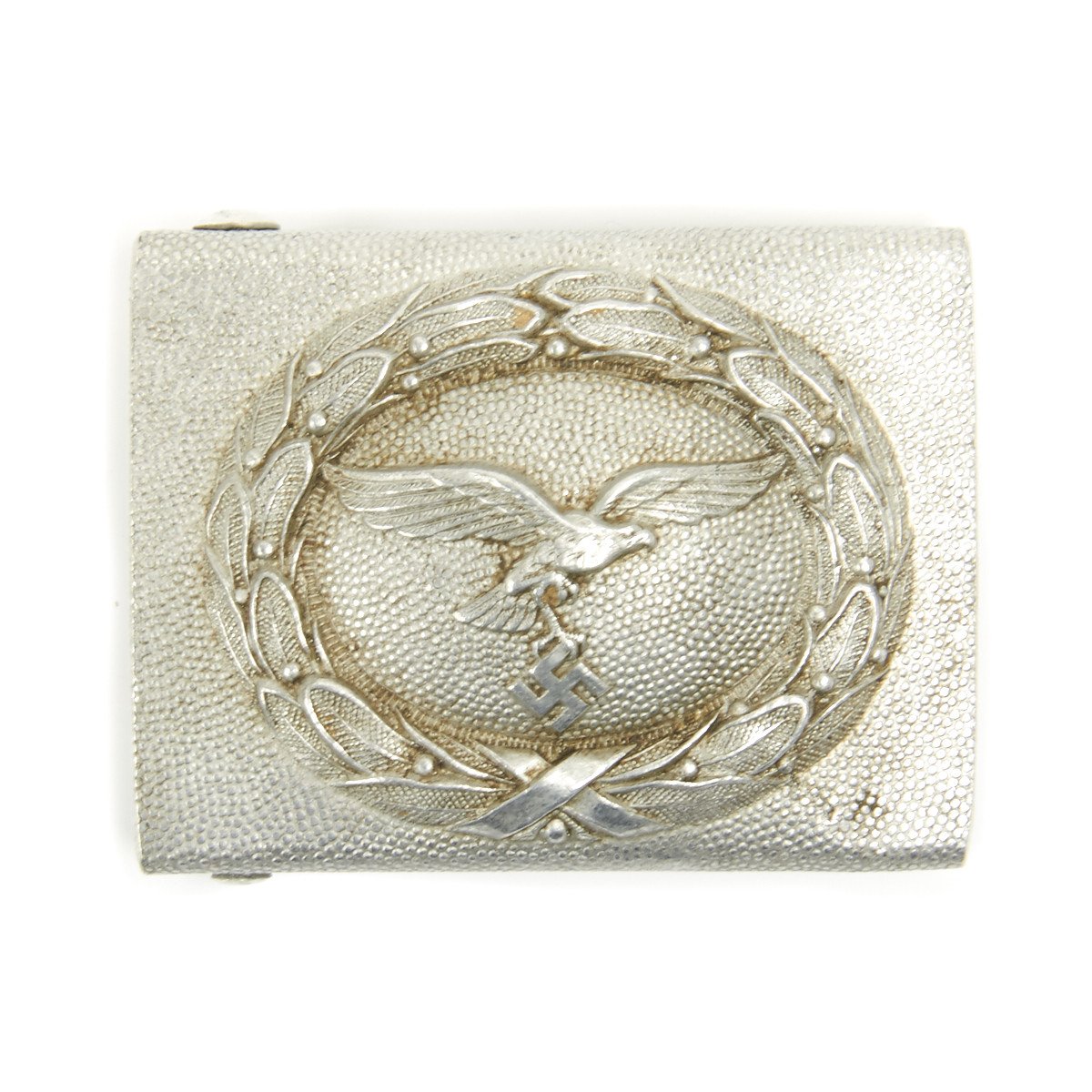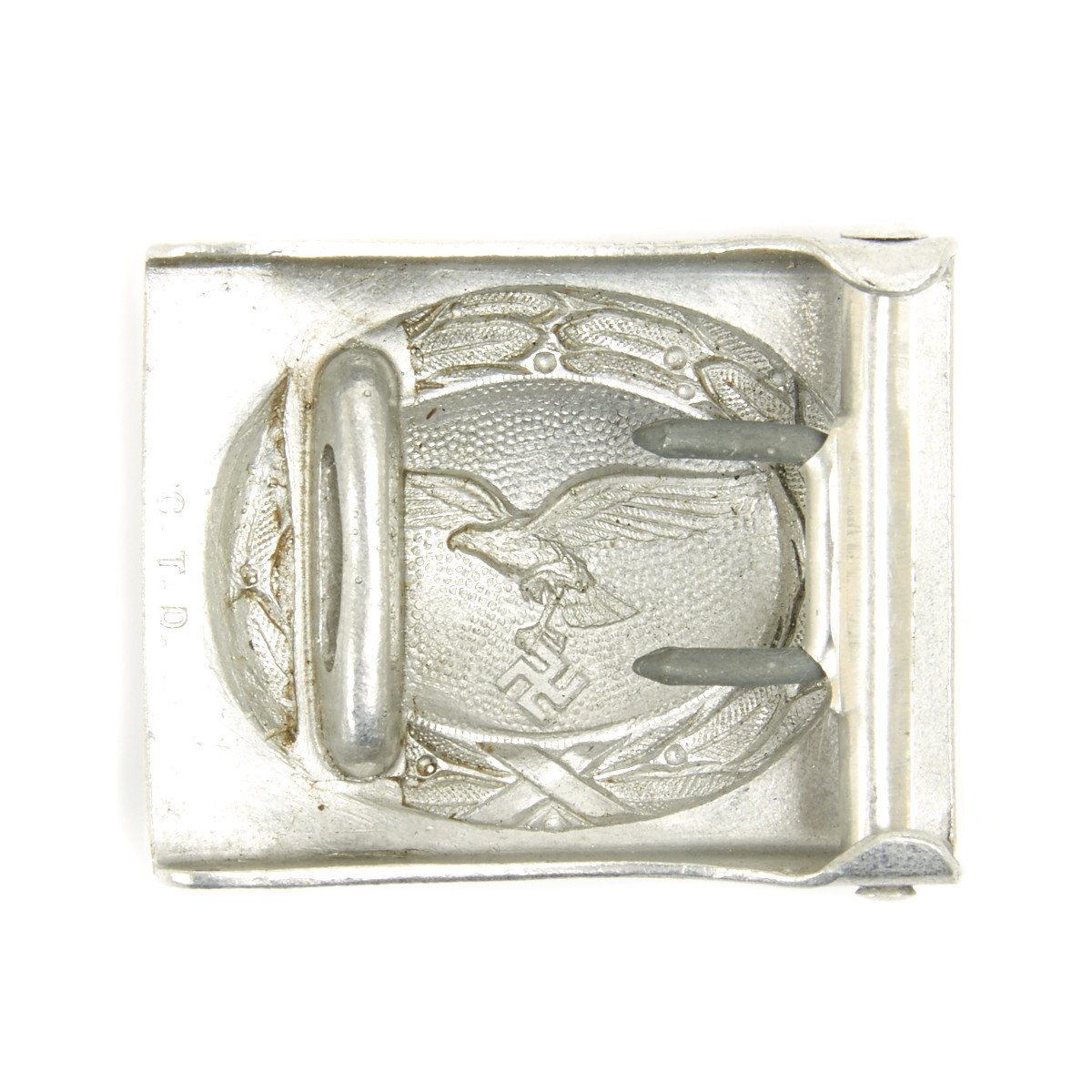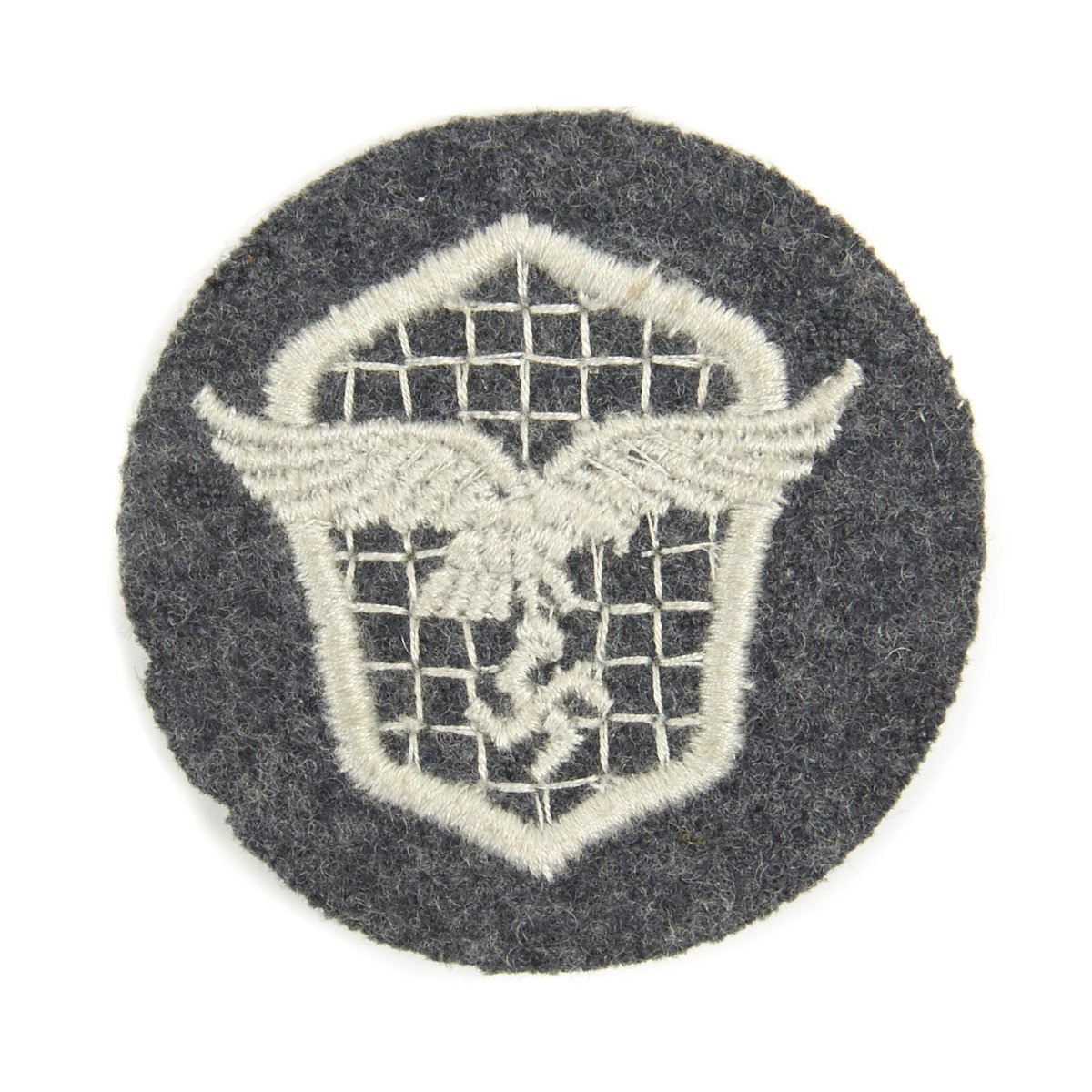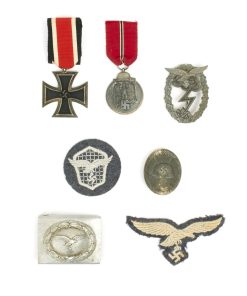Original German WWII Luftwaffe Medal and Insignia Grouping Original Items
$ 995,00 $ 248,75
Original Items: Only One Grouping Available. The Luftwaffe was the aerial warfare branch of the German Wehrmacht during World War II. When the Second World War began, the Luftwaffe was one of the most technologically advanced air forces in the world. During the Polish Campaign that triggered the war, it established air superiority, and then air supremacy, quickly. It supported German Army (Heer) operations which ended the campaign in five weeks. The Luftwaffe’s performance was as the Oberkommando der Luftwaffe had hoped. The Luftwaffe had rendered invaluable support to the army,[69] mopping up pockets of resistance. Göring was delighted with the performance. Command and control problems were experienced, but owing to the flexibility and improvisation of both the army and Luftwaffe, these problems were solved. The Luftwaffe was to have in place a ground-to-air communication system, which played a vital role in the success of Fall Gelb.
In the spring of 1940, the Luftwaffe assisted the Kriegsmarine and Heer in the daring invasion of Norway, Operation Weserübung. Flying in reinforcements and winning air superiority, the Luftwaffe contributed decisively to the German conquest and expulsion of the Western Allies from Scandinavia.
In the summer of 1940, the Luftwaffe contributed to the unexpected success in the Battle of France. It helped destroy three Allied Air Forces and secure the defeat of France in just over six weeks.[73] However, during the Battle of Dunkirk despite intense bombing, it could not deliver Göring’s promise to destroy the British Expeditionary Force, which escaped to continue the war.[74]
Gun camera film shows tracer ammunition from a Supermarine Spitfire Mark I of No. 609 Squadron RAF, flown by Flight Lieutenant J. H. G. McArthur, hitting a Heinkel He 111 on its starboard quarter.
During the Battle of Britain, the Luftwaffe, despite causing severe damage to the Royal Air Force’s infrastructure and British cities during the subsequent Blitz, did not achieve the air superiority that AH demanded for Operation Sea Lion[75] as the invasion was cancelled in December 1940, when AH ordered preparations to be made for Operation Barbarossa, the invasion of the Soviet Union. The following spring, the Luftwaffe helped its Axis partner, Italy secure victory in the Balkans Campaign and continued to support the Italians in the Mediterranean, Middle East and African theatres until May 1945.
In June 1941, Germany invaded the Soviet Union. The Luftwaffe destroyed thousands of Soviet aircraft, yet it failed to destroy the Red Air Force altogether. Due to a lack of Strategic bombers the very “Ural bombers” that General Wever had asked for six years before the Luftwaffe could not strike at Soviet production centers regularly or with the needed force. As the war dragged on, the Luftwaffe was eroded in strength. The defeats at the Battle of Stalingrad and Battle of Kursk ensured the gradual decline of the Wehrmacht on the Eastern Front.
British historian Frederick Taylor asserts that “all sides bombed each other’s cities during the war. Half a million Soviet citizens, for example, died from German bombing during the invasion and occupation of Russia. That’s roughly equivalent to the number of German citizens who died from Allied raids”.
Meanwhile, the Luftwaffe continued to defend German-occupied Europe against the growing offensive power of RAF Bomber Command and, starting in the summer of 1942, the steadily building strength of the United States Army Air Forces. The Defence of the Reich campaign gradually destroyed the Luftwaffe’s fighter arm. Despite its belated use of advanced turbojet and rocket propelled aircraft for bomber destroyer duties, it was overwhelmed by Allied numbers and a lack of trained pilots and fuel. A last-ditch attempt, known as Operation Bodenplatte, to win air superiority on 1 January 1945 failed. After the Bodenplatte effort, the Luftwaffe ceased to be an effective fighting force.
German day and night fighter pilots claimed roughly 70,000 aerial victories during World War II, 25,000 over British or American and 45,000 over Russian flown aircraft. 103 German fighter pilots shot down more than 100 enemy aircraft for a total of roughly 15,400 aerial victories. Roughly a further 360 pilots claimed between 40 and 100 aerial victories for round about 21,000 victories. Another 500 fighter pilots claimed between 20 and 40 victories for a total of 15,000 victories. It is relatively certain that 2,500 German fighter pilots attained ace status, having achieved at least 5 aerial victories. These achievements were honored with 453 German day and Zerstörer (destroyer) pilots having received the Knight’s Cross of the Iron Cross. 85 night fighter pilots, including 14 crew members, were awarded the Knight’s Cross of the Iron Cross.[79] Losses on the other hand were very high as well. Estimated total number of destroyed and damaged for the war totaled 76,875 aircraft, of which 40,000 were total losses and the remainder significantly damaged. By type, losses totaled 21,452 fighters, 12,037 bombers, 15,428 trainers, 10,221 twin-engine fighters, 5,548 ground attack, 6,733 reconnaissance, and 6,141 transports.
This grouping is 100% authentic (no reproductions) and consists of the following items:
– Iron Cross 2nd Class (Eisernes Kreuz 2. Klasse – abbreviated as EK II or E.K.II.) The Iron Cross was awarded for bravery in battle as well as other military contributions in a battlefield environment. The Iron Cross 2nd Class came with a ribbon and the cross itself was worn in one of two different ways: From the second button in the tunic for the first day after award. When in formal dress, the entire cross was worn mounted alone or as part of a medal bar.
– Eastern Front Medal. The Eastern Front Medal (German: Medaille Winterschlacht im Osten 1941/42) was a World War II German military decoration awarded to both German and Axis personnel. It was for those who served on the German Eastern Front during the “first winter campaign” period of 15 November 1941 to 15 April 1942. It was instituted on 26 May 1942 and was commonly known as the Ostmedaille (East Medal). Geographic limits were placed on its award of east of Ukraine and Ostland or in the Finnland area, east of the 1940 Russo/Finnish border. It was officially decommissioned by Oberkommando der Wehrmacht on 4 September 1944. The medal was wryly called the Frozen Meat Medal or the “Order of the Frozen Flesh” (German: Gefrierfleischorden) by Heer, Luftwaffe and Waffen-SS personnel to whom it was awarded. They qualified for the badge after a minimum of 14 days served in active combat; 30 days of flying personnel over enemy held land; 60 days of continuous service in a “combat zone”; being wounded or suffering a “frozen limb”, severe enough to warrant the issue of a Wound Badge.
– Ground Assault Badge of the Luftwaffe (Pre-1944). The Ground Assault Badge of the Luftwaffe (German: Erdkampfabzeichen der Luftwaffe) was a World War II German military decoration awarded to Luftwaffe personnel for achievement in ground combat. It was instituted on 31 March 1942 by the commander-in-chief (Oberbefehlshaber der Luftwaffe) Hermann Göring. The general criteria for its presentation was the participation in three separate combat operations on separate days. Luftwaffe soldiers who had already been awarded medals or orders of the Heer such as Assault Badge or the Infantry Assault Badge, were required to exchange their badges for the Ground Assault Badge of the Luftwaffe.
– Luftwaffe Motor Vehicle Driver Trade Badge (Kraftfahrpersonal Tätigkeitsabzeichen). The Luftwaffe utilized a wide variety of trade specialty badges, introduced at various times, for issue to qualified EM/NCO’s after successful completion of the appropriate training courses. The distinctive trade badges were generally worn on the lower left sleeve of the service tunic and the flight and field blouses as identifying insignia. The Motor Vehicle Drivers trade badge was introduced on November 8TH 1935, for wear by all EM/NCO personnel who had fulfilled the requirements to obtain a military drivers license and were appointed as a driver. Regulations in mid-1942 introduced gilt cord piping for the Motor Vehicle Drivers trade badge to signify “distinguished performance as a driver”. When issued with the additional gilt cord piping the badge came accompanied with an “award” certificate. Of Note: The Motor Vehicle Drivers trade badge should not be confused with the Armed Forces Driver’s Proficiency Badges that were introduced on October 23RD 1942 and were awarded for exceptional driving ability and vehicle maintenance in combat. The badge consists of a Luftwaffe blue/grey wool base with a machine embroidered, stylized Luftwaffe eagle superimposed on the likeness of a vehicle radiator grill, all in silver/grey threads. The badge measures approximately 55mm in diameter.
– Silver (2nd class) Wound Badge for being wounded three or four times. The Wound Badge (German: Verwundetenabzeichen) was a military decoration first promulgated by Wilhelm II, German Emperor on 3 March 1918, which was awarded to wounded or frostbitten soldiers of the Imperial German Army, during World War I. Between the world wars, it was awarded to members of the German armed forces who fought on the Nationalist side of the Spanish Civil War, 193839, and received combat related wounds. It was awarded to members in the Reichswehr, the Wehrmacht, SS and the auxiliary service organizations during the Second World War. After March 1943, due to the increasing number of Allied bombings, it was also awarded to wounded civilians in air raids. It was awarded when the wound was the result of enemy hostile action, with an exception being for frost-bite.
– Aluminum Luftwaffe Bel Buckle. The design of the buckle consists of a heavy pebbled surface. A wreath forms an oval shape that holds a flying Luftwaffe eagle in the center. The eagle is clutching a swas with one claw while holding the second claw up in the air. The detail of the plumage and the leaves of the wreath is crisp and excellent.
– Luftwaffe Uniform Embroidered Breast Eagle This is a Luftwaffe 1 1/2 inch by 3 1/2 inch near excellent eagle.
Fast Shipping with Professional Packaging
Thanks to our longstanding association with UPS FedEx DHL, and other major international carriers, we are able to provide a range of shipping options. Our warehouse staff is expertly trained and will wrap your products according to our exact and precise specifications. Prior to shipping, your goods will be thoroughly examined and securely secured. We ship to thousands clients each day across multiple countries. This shows how we're dedicated to be the largest retailer on the internet. Warehouses and distribution centres can be located throughout Europe as well as the USA.
Note: Orders with more than one item will be assigned a processing date depending on the item.
Before shipping before shipping, we'll conduct a thorough inspection of the items you have ordered. Today, the majority of orders will be delivered within 48 hours. The delivery time will be between 3-7 days.
Returns
The stock is dynamic and we cannot completely manage it because multiple stakeholders are involved, including our factory and warehouse. So the actual stock may alter at any time. It's possible that you may not receive your order once the order has been made.
Our policy is valid for a period of 30 days. If you don't receive the product within 30 days, we are not able to issue a refund or an exchange.
You can only return an item if it is unused and in the same state as the day you received it. You must have the item in its original packaging.
Related products
Uncategorized
Uncategorized
Uncategorized
Armoured Fighting Vehicles of the World: AFVs of World War One (Hardcover Book) New Made Items
Uncategorized
Band of Brothers ORIGINAL GERMAN WWII Le. F.H. 18 10.5cm ARTILLERY PIECE Original Items
Uncategorized
Armored Burgonet Helmet & Polearm from Scottish Castle Leith Hall Circa 1700 Original Items
Uncategorized
Uncategorized
Uncategorized
Uncategorized
Australian WWII Owen MK1 Machine Carbine SMG Custom Fabricated Replica with Sling Original Items
Uncategorized
Uncategorized
Uncategorized
Angolan Rebel 1970s era 60mm Inert Display Mortar from Angolan Civil War Original Items
Uncategorized
Uncategorized
Uncategorized
Uncategorized
Uncategorized
Uncategorized
